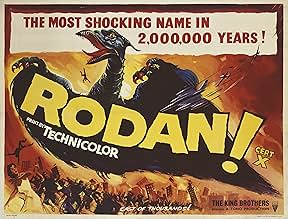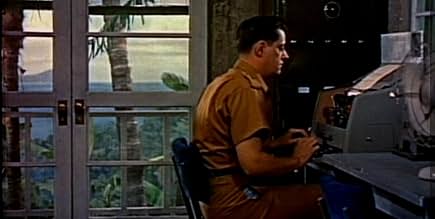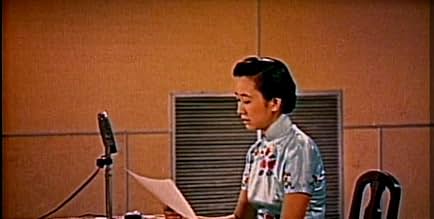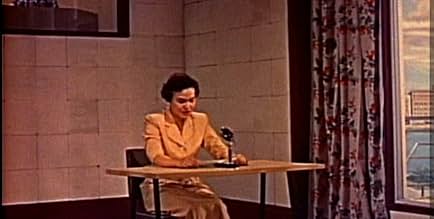NOTE IMDb
6,2/10
6,4 k
MA NOTE
Ajouter une intrigue dans votre langueA mining engineer investigates the deaths of his colleagues, discovering prehistoric nymphs and a creature capable of flying - and wreaking havoc - at supersonic speeds.A mining engineer investigates the deaths of his colleagues, discovering prehistoric nymphs and a creature capable of flying - and wreaking havoc - at supersonic speeds.A mining engineer investigates the deaths of his colleagues, discovering prehistoric nymphs and a creature capable of flying - and wreaking havoc - at supersonic speeds.
- Réalisation
- Scénario
- Casting principal
Kenji Sahara
- Shigeru Kawamura, colliery engineer
- (as Kenji Sawara)
Kiyoharu Onaka
- Male Honeymooner, Sunagawa's friend
- (as Kiyoharu Ohnaka)
Mike Danning
- American Soldier Typing
- (as Mike Daneen)
Tsurue Ichimanji
- Haru, Kiyo's neighbor
- (as Tazue Ichimanji)
Avis à la une
Ishiro Honda directed this film, which starts off in a small Japanese mining community beset by mysterious killings and disappearances that turn out to be caused by giant insects who are later found to be sealed up in a cavern with Rodan, a giant flying prehistoric bird/lizard that escapes, then attacks Japan(still recovering from Godzilla!) It proves difficult to kill, and as it turns out, isn't alone, and has an egg it's guarding to boot... First film appearance of Rodan(and it's only solo film) has an imaginative opening sequence with the mine subplot, though picks up when Rodan finally appears, even though it's just an airborne version of Godzilla. The surviving Rodan would make return appearances in the Godzilla series, starting with "Ghidorah, The Three-Headed Monster".
The first of the Toho "Dai Kaiju" series in colour and some of Eiji Tsuburaya's best special effects. Although shorn to a miserly 69 minutes of the original Japanese footage (plus nearly 4 minutes of actual H-Bomb test footage stuck to the beginning by the American distributors, The King Brothers) it is a fabulously made picture.
Coal miners discover gigantic insects, known as Meganurons in the original version, which attack the local village. As if that were not bad enough a monstrous flying reptile soon hatches from an egg which has also been unearthed. Rodan's appearance is a "good news/bad news" thing because he eats the giant insects, but he also causes more damage than they ever could have!
The King Brothers, who would also give us GORGO a few years later, saved money by simply repeating certain scenes and "flopping" the image on the screen so it would look (slightly) different. Rodan and its mate appear out of the same crater in the American version. In the original version the second Rodan appears with no explanation as the first one is destroying the city of Sasebo. The narration probably saved time and allowed them to use less of the Japanese footage but having seen the original version I prefer the visual aspects of it (the end sequence is just as poignant and memorable without any dialogue).
Lovers of dubbed movies will recognise the voices of Paul Frees and Marvin Miller doing almost every voice in the picture! Keye Luke, a former Number One Son in Charlie Chan movies, provides the voice of the hero and a teenaged George Takei (later Mr. Sulu on "Star Trek") can be heard also. Look carefully during the destruction of the city and you will notice one building, a camera company, is called "The Tsuburaya Company"!
In todays genres where every movie is over-laden with CGI people should pause long enough to watch this movie and see what could be done with miniatures, imagination, and heart. Eiji Tsuburaya really loved the genre and gave his best to every assignment but THIS will always be one of his best.
Oh and about the monsters name. It was originally RADON but a British toy company had a doll on the market with that name so when the movie went abroad they simply switched the vowels in the monster's name and Radon became Rodan.
Coal miners discover gigantic insects, known as Meganurons in the original version, which attack the local village. As if that were not bad enough a monstrous flying reptile soon hatches from an egg which has also been unearthed. Rodan's appearance is a "good news/bad news" thing because he eats the giant insects, but he also causes more damage than they ever could have!
The King Brothers, who would also give us GORGO a few years later, saved money by simply repeating certain scenes and "flopping" the image on the screen so it would look (slightly) different. Rodan and its mate appear out of the same crater in the American version. In the original version the second Rodan appears with no explanation as the first one is destroying the city of Sasebo. The narration probably saved time and allowed them to use less of the Japanese footage but having seen the original version I prefer the visual aspects of it (the end sequence is just as poignant and memorable without any dialogue).
Lovers of dubbed movies will recognise the voices of Paul Frees and Marvin Miller doing almost every voice in the picture! Keye Luke, a former Number One Son in Charlie Chan movies, provides the voice of the hero and a teenaged George Takei (later Mr. Sulu on "Star Trek") can be heard also. Look carefully during the destruction of the city and you will notice one building, a camera company, is called "The Tsuburaya Company"!
In todays genres where every movie is over-laden with CGI people should pause long enough to watch this movie and see what could be done with miniatures, imagination, and heart. Eiji Tsuburaya really loved the genre and gave his best to every assignment but THIS will always be one of his best.
Oh and about the monsters name. It was originally RADON but a British toy company had a doll on the market with that name so when the movie went abroad they simply switched the vowels in the monster's name and Radon became Rodan.
This film is one of the best of the kaiju eigas that Toho ever made. The reason for this is that it is played much like the movie that in a way inspired it, "Them". The way the film begins plays almost like them did, the police and mine workers wondering who, or what, is responsible for the deaths of four men. The tension builds and builds from the first appearance of the giant insects to the destruction of Fukuoka (for some reason called Sasebo in the American version). Even though Rodan the monster did not become as successful as Godzilla, the film is more of a thrill ride and definitely should be hailed as a great science fiction film.
"Rodan" was one of the few Japanese monster movie classics that were not only heavily altered for its release into the United States, but was re-edited with respect and care for the original vision of its director Ishiro Honda. As a result, even though the Japanese and English versions are different, both are highly stimulating and tremendously enjoyable monster mashes and it's no surprise why "Rodan" was such a big hit in both countries. This is one of the most purely enjoyable, yet complex and captivating science-fiction films ever made and also boasts some surprisingly grand special effects sequences, a commendable music score, and fantastic directing by Ishiro Honda.
Rodan, a popular pterodactyl-like monster, had his debut in this 1956 film, although he does not even make an appearance until the movie is nearly over. The picture starts out with a local mining village being placed under attack by giant clawed insects crawling out of the caverns in which they harvest coal for a living. After the prehistoric arthropods brutally slaughter seven people, an investigation is conducted and a more horrifying truth is discovered. Something other than giant bugs may have resurfaced sometime after the testing of the H-bomb and at the same time, an object capable of flying at supersonic speed is spotted attacking aircraft all over the world.
It's the complexity of the story and the plot that I still find really captivating about "Rodan." If it weren't for the title, we would assume that Rodan is not even in the movie at all. We'd think it was about giant bugs. Sort of like a Japanese equivalent of "Them!" the great James Arness flick with giant ants. Rodan does not make a full-fledged appearance until the movie is nearly over and when he does show up, it's with tremendous awe and presence. The fact that Rodan is also created with some surprisingly grand special effects is another key element to his interesting qualities as a movie monster. Instead of plodding through miniature buildings like Godzilla, Rodan whips across the screen with dazzling speed and produces hurricane winds and shock waves to devastate his foes and victims. The audio track is pumped up with earsplitting shrieks as Rodan breaks the sound barrier and his trademark cry here is really a very disturbing and spine-tingling noise. Sequences such as Rodan attacking a plane (inspired by the infamous Thomas F. Mantell UFO incident) and fighting jets in a supersonic dogfight are truly exhilarating. Furthermore, we've got a cast of characters who are worth caring about. The great Japanese actor Kenji Sahara plays the titular role of Shigeru Kawamura, one of the miners who stumbles upon one horrifying event after another. And he has connections with the other characters, most notably with Yumi Shirakawa. Their relationship and chemistry is almost as fascinating as the monsters.
When the movie was distributed into the United States, like with the first Godzilla pictures, changes were made. Unlike however with that film, the changes here were more considerate and honorable. As long as you can forgive the hammy, sometimes irritating narration by Keye Luke, you can respect the distributors' decisions such as improving editing changes and addition or re-arrangement of musical cues. As an overall movie, the Japanese version feels more complete, more wholesome, and is a better picture. But its English counterpart is very nearly on par with its kinetic energy and confidence.
The cast is in terrific shape. Kenji Sahara is a truly talented actor and those who say otherwise (that no Japanese monster movie can have good acting) just look at his expression as he tries to overcome amnesia and try to say that again with a straight face. Yumi Shirakawa is also terrific as his love interest, Akhiko Hirata is once again convincing and commendable as the obligatory scientist wanting to learn the truth, and Akio Korobi not only has the physical appearance of a police chief, but plays one with presence.
"Rodan" is an unfortunately overlooked monster movie masterpiece. Most people who know it are only so because the Rodan character would later become affiliated with the Godzilla franchise. Now that the original Japanese version has been nicely given a DVD release in the U.S., I hope people can truly appreciate how great this genuinely spectacular science-fiction classic is. It is complex, well-written, drawn-out, and the ending of the picture is surprisingly moving.
Rodan, a popular pterodactyl-like monster, had his debut in this 1956 film, although he does not even make an appearance until the movie is nearly over. The picture starts out with a local mining village being placed under attack by giant clawed insects crawling out of the caverns in which they harvest coal for a living. After the prehistoric arthropods brutally slaughter seven people, an investigation is conducted and a more horrifying truth is discovered. Something other than giant bugs may have resurfaced sometime after the testing of the H-bomb and at the same time, an object capable of flying at supersonic speed is spotted attacking aircraft all over the world.
It's the complexity of the story and the plot that I still find really captivating about "Rodan." If it weren't for the title, we would assume that Rodan is not even in the movie at all. We'd think it was about giant bugs. Sort of like a Japanese equivalent of "Them!" the great James Arness flick with giant ants. Rodan does not make a full-fledged appearance until the movie is nearly over and when he does show up, it's with tremendous awe and presence. The fact that Rodan is also created with some surprisingly grand special effects is another key element to his interesting qualities as a movie monster. Instead of plodding through miniature buildings like Godzilla, Rodan whips across the screen with dazzling speed and produces hurricane winds and shock waves to devastate his foes and victims. The audio track is pumped up with earsplitting shrieks as Rodan breaks the sound barrier and his trademark cry here is really a very disturbing and spine-tingling noise. Sequences such as Rodan attacking a plane (inspired by the infamous Thomas F. Mantell UFO incident) and fighting jets in a supersonic dogfight are truly exhilarating. Furthermore, we've got a cast of characters who are worth caring about. The great Japanese actor Kenji Sahara plays the titular role of Shigeru Kawamura, one of the miners who stumbles upon one horrifying event after another. And he has connections with the other characters, most notably with Yumi Shirakawa. Their relationship and chemistry is almost as fascinating as the monsters.
When the movie was distributed into the United States, like with the first Godzilla pictures, changes were made. Unlike however with that film, the changes here were more considerate and honorable. As long as you can forgive the hammy, sometimes irritating narration by Keye Luke, you can respect the distributors' decisions such as improving editing changes and addition or re-arrangement of musical cues. As an overall movie, the Japanese version feels more complete, more wholesome, and is a better picture. But its English counterpart is very nearly on par with its kinetic energy and confidence.
The cast is in terrific shape. Kenji Sahara is a truly talented actor and those who say otherwise (that no Japanese monster movie can have good acting) just look at his expression as he tries to overcome amnesia and try to say that again with a straight face. Yumi Shirakawa is also terrific as his love interest, Akhiko Hirata is once again convincing and commendable as the obligatory scientist wanting to learn the truth, and Akio Korobi not only has the physical appearance of a police chief, but plays one with presence.
"Rodan" is an unfortunately overlooked monster movie masterpiece. Most people who know it are only so because the Rodan character would later become affiliated with the Godzilla franchise. Now that the original Japanese version has been nicely given a DVD release in the U.S., I hope people can truly appreciate how great this genuinely spectacular science-fiction classic is. It is complex, well-written, drawn-out, and the ending of the picture is surprisingly moving.
This is a really well made movie. The colors are great and the effects are pretty coll for 50 years ago. I love to watch these sort of movies with my six year old. Todays kids cannot see horror movies anymore because of the gore. So I have introduced him to the classics and as such enjoy the hell out of watching these sort of movies with him. The modern world has really lost that special something that comes with engaging the imagination as many of us did in the sixties and even the seventies. Rodan is probably the best of all the old toho movies. At least I know it's my favorite. Now soon comes the last in the series this Christmas and it should prove to be waesome.
Le saviez-vous
- AnecdotesThe cable supporting Rodan over Sasebo Bridge snapped, causing suit actor Haruo Nakajima to fall 25 feet into the water. The incident is left in the movie as the scene where Rodan dives into the water near the bridge and submerges. The cables were re-attached for the scene where Rodan lifts off out of the water, but they almost broke again because the suit became waterlogged and doubled in weight.
- GaffesThe opening title says "Rodan © COPYRIGHT MCMXXX1V TOHO CO. LTD." This 1956 film was not copyrighted in 1934.
- Citations
Professor Kyuichiro Kashiwagi (biology): Judging from a piece of its eggshell that we discovered, this one, which we've named Rodan, has a wingspan of 270 feet and weights over 100 tons.
- Crédits fousIn the U.S. version, special effects director Eiji Tsuburaya's name is misspelled "Eiji Tsuburya."
- Versions alternativesIn the original Japanese version, there is no dialogue prior to Rodan's attack on the two honeymooners. The American version later added dialogue in which the young woman was joking about her husband taking pictures of the volcano rather than her. Also, in the original version the scene plays a little longer with Rodan making a pass above the couple, with his shadow passing over them, before he swoops in to carry the couple off.
- ConnexionsEdited into Hector Servadac (1961)
Meilleurs choix
Connectez-vous pour évaluer et suivre la liste de favoris afin de recevoir des recommandations personnalisées
- How long is Rodan?Alimenté par Alexa
Détails
Box-office
- Montant brut aux États-Unis et au Canada
- 500 000 $US
- Week-end de sortie aux États-Unis et au Canada
- 500 000 $US
- 6 août 1957
- Durée1 heure 22 minutes
- Rapport de forme
- 1.37 : 1
Contribuer à cette page
Suggérer une modification ou ajouter du contenu manquant
























